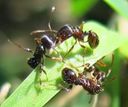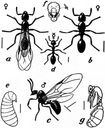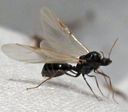(Immigrant) Pavement Ant
Tetramorium immigrans
Classification
- Phylum: Arthropoda
- Subphylum: Hexapoda
- Class: Insecta
- Order: Hymenoptera
- Superfamily: Formicoidea
- Family: Formicidae
- Subfamily: Myrmicinae
- Tribe: Crematogastrini
- Genus: Tetramorium
- Species: immigrans
Pronunciation
How to pronounce Tetramorium immigrans: /tɛtraˈmoʊriəm ˈɪmɪɡrænz/
These audio files are automatically generated. While they are not always 100% accurate, they are a good starting point.
Images






Summary
Tetramorium immigrans, known as the immigrant pavement ant, is a common species in urban and suburban areas of North America. Originally native to Europe, it has adapted well to human-altered environments, creating extensive underground nests and engaging in large battles with neighboring colonies.
Physical Characteristics
Dark brown to blackish, 2.5–4 millimeters (0.10–0.16 in) long, with a single pair of spines on the back and two nodes on the petiole; grooves on the head and thorax; workers have a small stinger.
Identification Tips
Look for entrance holes surrounded by small crater-shaped mounds of sand in summer. Distinguished by the presence of two nodes on the petiole and a pair of spines on the back.
Habitat
Urban parks, yards, vacant lots, under sidewalks and building rubble, especially in areas with little vegetation. Adapted to urban environments.
Distribution
Native to Southern and Central Europe, introduced and found throughout the United States and Southern Canada, mostly absent in the southern tier US states.
Diet
Omnivorous; feeds on greasy human food scraps, other insects, seeds, honeydew, honey, bread, meats, nuts, ice cream, and cheese.
Life Cycle
Nuptial flights occur in spring and summer; queens and drones leave the nest to mate. Queens establish new colonies by digging a clausteral chamber.
Reproduction
Monogynous colonies typically have one queen. The queen raises the first generation of young alone until they can forage.
Predators
Natural predators of codling moth larvae; may be preyed upon by other ant species and predators like birds.
Ecosystem Role
Important scavengers in urban environments; participate in soil aeration through their nesting activities.
Economic Impact
Considered a nuisance pest in urban settings; can affect human activities by invading homes in search of food.
Health Concerns
Stinging from workers can cause mild discomfort, but is generally harmless to humans.
Collecting Methods
- Pitfall traps
- Sweep nets
Preservation Methods
- Alcohol preservation
- Pin mounting
Evolution
Part of the Tetramorium caespitum complex; evolved as a separate species with low genetic diversity in North America suggests it originated from a small number of introduced colonies.
Misconceptions
Often confused with Tetramorium caespitum due to historical classification.
Tags
- Tetramorium immigrans
- pavement ant
- invasive species
- urban ecology
- ant behavior